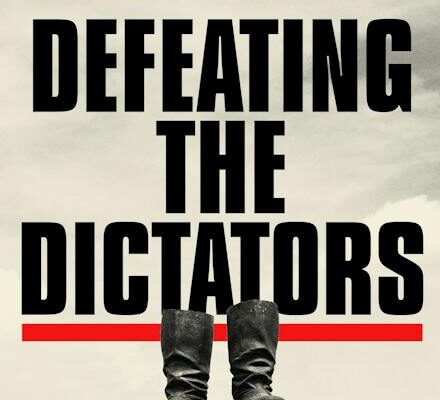Defeating the dictators

When reading a political text – or at least one purporting to be – wariness about the tinsel of political endorsement should be encouraged. Too often, such works resemble a call to arms, the trumpeting for a cause, a rosy vision to be realised.
What we sometimes find is a policy geared to programmatic goals more than firm prognostication, the yielding of the critical eye to the confident panaceas of the policy guru. Charles Dunst dons the garb of a guru in Defeating the Dictators, and has seemingly found devotees among US ambassadors, members of the US Congress, the UK Parliament, and a number of military and national security personnel.
His work capitalises on what is perceived to be a malaise with the democratic experiment, perpetuating a continuing wonder about why democracies wax and wane before seemingly more muscular, authoritarian alternatives.
He opens with a discussion about Singapore, the city state of authoritarian dreams and common law fancies. Its founding premier, Lee Kuan Yew, was famous for thinking that order took precedence over law, and let his opponents know it. Struck by its efficiency, cleanliness, and professionalism, Dunst is troubled in admiration. The city state’s politicians and institutions are said to be incorruptible. Yet, it is an authoritarian country shadowed by the death penalty. How, then, would it be possible to marry economic prosperity with democratic governance?
In this self-confessed “aspirational” book, the author suggests a number of solutions. To aid the health of democracies, better attention should be spent on sober, well calibrated funding choices. Doing so improves levels of trust in government. Given their generous returns, Dunst suggests that extensive capital and infrastructure projects should be encouraged.
He contrasts the US$1 trillion infrastructure bill pushed through by the Biden administration, a mere 1.25 percent of GDP, with the infrastructure budget of the People’s Republic of China (PRC), which came in at 8.5 percent of GDP from 1992 to 2011. European states did not do much better. “China today spends more on infrastructure than the United States and Europe do combined.”
He also recommends less stringent immigration policies, a policy currently at odds with sentiment across the Anglosphere and European countries. He is also a proponent of improving the social safety net. “Without an improved social safety net, what awaits us are more autocrats, fewer democrats, and above all, less freedom.”
Ironically enough, this book misses the point that various political forces of the European Right are most keen to not only preserve social safety nets but enhance them; their reserve, as expressed by the likes of Hungary’s Viktor Orbán and Italian Prime Minister Giorgia Meloni, is with immigration itself, which they see as mutually incompatible with the goals of such welfare.
Dunst finds himself in something of a bind when discussing the nature of authoritarianism. The China of Xi Jinping and the Russia of Vladimir Putin are seen in similar terms, as are a number of disparate states: Hungary, Venezuela, Iran, Turkey, and Belarus, for instance. There is little by way of a viable taxonomy here.
But Singapore is heralded as the “autocratic exception” from which democracies can learn. “Democracies can do what Singapore has done even better, thanks to the inherent strength of liberalism.” Interestingly, and incongruously enough, Dunst advises readers that such a singular city state is not a model “that any autocracy today can truly follow.”
What is not always clearly articulated is the supposed threat posed by such authoritarian states. On the one hand, they are weak, dysfunctional and offer few solutions of lengthy duration, something that would surely sit well with democratic states. Economic stability may well be promised by autocracies, but democracies offer, in Dunst’s Jeffersonian mimicry, “more freedom, equality and opportunities to pursue happiness.”
On the other hand, such authoritarian systems constitute “an autocratic challenge to spur action.” In addressing them, democracies will, the author says rather vaguely, “produce better governance at home, fuelling more productivity, more growth and better democracy – because it is not sustainable for people to trust democracy less than ever before.”
Dunst contends that democratic states need to go on a public relations drive, dust the image, repackage the message. Convince their citizens, for instance, that immigrants aid, rather than impair, their societies. Education, notably of such elite institutions as Oxbridge in the UK and the Ivy League schools in the US, should be democratised to improve social mobility. The “legacy” tradition, notably in such universities as Harvard, should be modified for, according to Dunst, poorly connected parents, when they see the poor performing students of politicians and financiers, “will vote for the would-be dictator.”
Ultimately, if democracies want to thrive as alternatives in the face of any autocratic solution, good governance remains necessary. Keep the powerful accountable. Help the vulnerable and aid those who stumble when needed. Ensure that services and public goods are ample and reliable. And, in the final analysis, use the autocratic threat positively to “prompt a bold shift in policy for the better.” Fine language from the guru suffused with aspiration; more problematic for policy makers more accustomed to mundane technocracy.
This review of Defeating the Dictators: How Democracy Can Prevail in the Age of the Strongman by Charles Dunst was published by the Australian Institute for International Affairs.
Dr. Binoy Kampmark was a Commonwealth Scholar at Selwyn College, Cambridge. He lectures at RMIT University, Melbourne. Email: bkampmark@gmail.com













